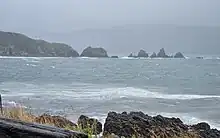Steeple Rock
Steeple Rock/Te Aroaro-o-Kupe is a large rock off Seatoun at the west of the entrance to Wellington Harbour, rising 7 metres (23 ft) above sea level. The rock plays a role in warning ships off the coast. It is the location of a marine light and an unbeaconed trig station (‘Steeple Rock Light’, geodetic code B0XX).
.jpg.webp)
Its Māori name is Te Aroaro-o-Kupe (The front of Kupe or The presence of Kupe[1]). The name was officially changed in 2009 from the English "Steeple Rock" to the current dual name of Steeple Rock/Te Aroaro-o-Kupe as part of the 2009 Treaty of Waitangi settlement between Taranaki Whānui ki te Upoko o te Ika and the New Zealand government.[2] The previous Māori name of the rock was Te Ure o Kupe (The penis of Kupe).[3][4][5] Kupe, the legendary discoverer of Aotearoa, is said to have injured himself on the rock while swimming.[6]

In earlier times Steeple Rock was also known as Pinnacle Rock.[7][8] This should not be confused with The Pinnacles, a group of rocks extending from the tip of Point Dorset, south of Steeple Rock.[9]
While Steeple Rock is not as much of a hazard to shipping as Barrett Reef to the south, several ships have got into trouble around the rock, for example:
- 1844 Royal William, sloop. Got stuck and had to be pulled off Steeple Rock.[10]
- 1874 Anne Melhuish, barque. Got stuck at Steeple Rock.[11]
- 1889 Willie McLaren, barque. Damaged when it hit a rock near Steeple Rock. Took on water, so the captain took the ship to Worser Bay where it sank.[12]
- 1921 Rona, barque. Ran aground on Steeple Rock.[13] Refloated and repaired.
- 1968 TEV Wahine, inter-island passenger ferry. The Wahine struck Barrett Reef and then drifted north until she foundered near Steeple Rock.[14] 53 lives lost.
The Steeple Rock Light was installed in 1934 in the water to the east of Steeple Rock. The structure consists of a two-part concrete shell that was moved to the site by the floating crane Hikitia, then filled with concrete. It originally ran on gas but was converted to solar power in 1993.[15]
References
- "Wellington Region - Early Māori History". Te Ara – The Encyclopedia of New Zealand. Retrieved 30 November 2016.
- "Port Nicholson Block (Taranaki Whānui ki Te Upoko o Te Ika) Claims Settlement Act 2009 No 26 (as at 30 November 2022), Public Act – New Zealand Legislation". www.legislation.govt.nz. Retrieved 23 February 2023.
- Te Whetu; Best, Elsdon (1893). "Te Haerenga Mai O Kupe I Hawaiki / The Coming of Kupe From Hawaiki to New Zealand". The Journal of the Polynesian Society. 2 (3): 147–151. ISSN 0032-4000. JSTOR 20701292 – via JSTOR.
- "Chapter III. — Kupe—the Navigator | NZETC". nzetc.victoria.ac.nz. Retrieved 23 February 2023.
- Saunders, T. V. (March 1969). "Kupe The Polynesian Navigator and Explorer". Te Ao Hou (66): 18 – via Papers Past.
- "Steeple Rock/Te Aroaro-o-Kupe". Land Information New Zealand (LINZ) - Toitū te whenua. Archived from the original on 30 August 2014.
- "[untitled]". Evening Post. 4 September 1876. Retrieved 21 January 2022 – via Paperspast.
... there was some target practice, the improvised target being the Pinnacle or Steeple Rock.
- "[untitled]". New Zealand Times. 9 July 1904. Retrieved 21 January 2022 – via Paperspast.
The Pinnacle Rock, off Seatoun, also bears a name conferred in memory of Kupe.
- "NZ Marine Charts". wetmaps.co.nz. Retrieved 21 January 2022.
- "County Court, Wellington". New Zealand Gazette and Wellington Spectator. 16 March 1844. Retrieved 21 January 2022 – via Paperspast.
- "Inquiry into the stranding of the Anne Melhuish". New Zealand Times. 12 November 1874. Retrieved 21 January 2022 – via Paperspast.
- "Another shipping disaster". New Zealand Times. 7 October 1889. Retrieved 21 January 2022 – via Paperspast.
- "Mishap off Seatoun". Evening Post. 27 June 1921. Retrieved 21 January 2022 – via Paperspast.
- "Wahine disaster map". NZ History. Retrieved 21 January 2022.
- Cochrane & Murray; Kelly, Michael; Dodd, Andy (30 June 2012). Coastal historic heritage of the Wellington Region : Survey for the coastal plan review [report] (PDF). Wellington, New Zealand: Greater Wellington Regional Council.
updated 31 October 2014